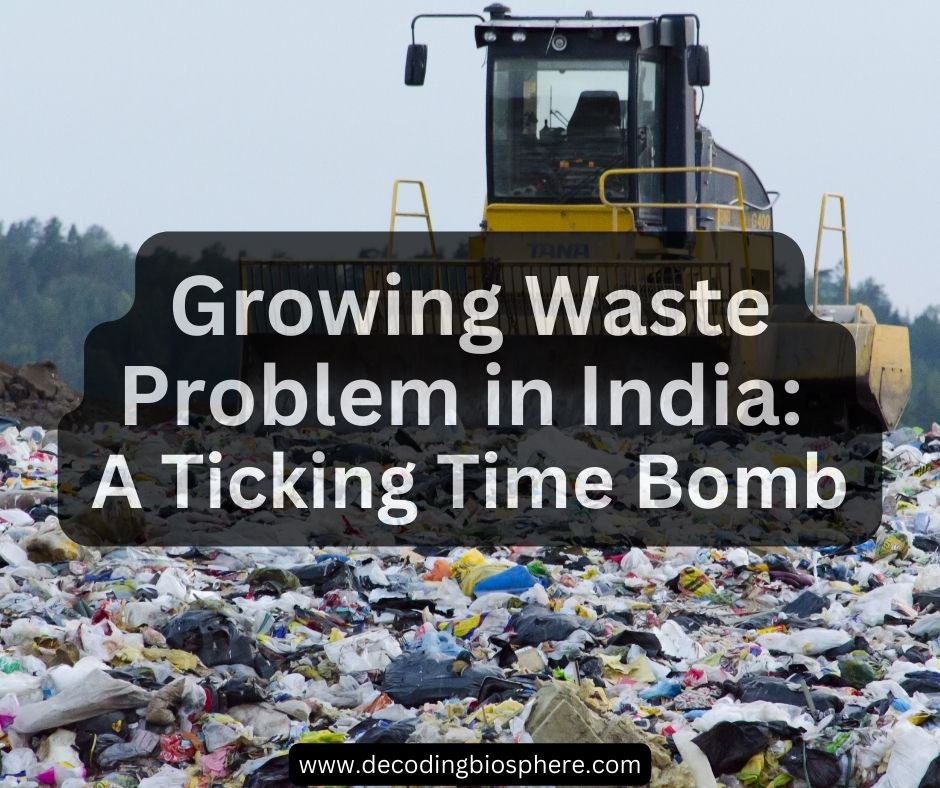India, a country known for its vibrant culture, rapid economic growth, and technological advancements, is now grappling with an escalating waste management crisis. The growing mountains of waste across the nation are becoming a significant environmental and health hazard, reflecting the urgent need for effective waste management strategies.
The Magnitude of the Problem
India generates approximately 62 million tonnes of waste annually, a figure that is expected to reach 165 million tonnes by 2030 if current trends continue . This alarming rise in waste generation is primarily driven by rapid urbanization, population growth, and changing consumption patterns.
Urbanization and Its Consequences
Urban areas are at the epicenter of India’s waste crisis. The urban population in India, currently around 35%, is projected to increase to 40% by 2030 . With this urban influx, waste generation in cities has surged. Major metropolitan areas like Mumbai, Delhi, and Bengaluru produce thousands of tonnes of waste daily. Mumbai alone generates over 11,000 tonnes of waste each day .
Waste Composition and Management Challenges
The composition of waste in India is diverse. About 60% of the waste is organic, 15% is recyclable, and the remaining 25% is inert waste, including construction debris . Despite the high organic content, only about 10% of this waste is processed through composting or biogas plants. The recycling rate, although higher than in some developing countries, is still far from optimal due to inadequate segregation at the source.
The infrastructure for waste management in India is woefully inadequate. Most cities lack proper waste collection and disposal systems. Around 70-80% of municipal solid waste is collected, but only 22-28% of this is processed . The rest ends up in overburdened landfills or, worse, is dumped indiscriminately.
Environmental and Health Implications
The environmental consequences of poor waste management are severe. Landfills, such as the ones in Ghazipur (Delhi) and Deonar (Mumbai), have grown to alarming heights, posing significant threats to the environment and public health. These sites emit harmful gases like methane, a potent greenhouse gas, contributing to air pollution and climate change. Leachate from these landfills contaminates groundwater, posing a risk to water quality and public health.
The health implications for residents living near these waste sites are dire. They suffer from respiratory problems, skin diseases, and other ailments due to exposure to toxic substances and poor air quality. The unregulated burning of waste, a common practice in many areas, exacerbates air pollution, contributing to the already high levels of particulate matter in Indian cities.
Economic Impacts
The economic cost of inefficient waste management is staggering. According to a study by the World Bank, poor waste management costs Indian cities around $40 billion annually . This includes healthcare costs, lost productivity, and environmental degradation. Effective waste management, conversely, has the potential to create jobs, promote recycling industries, and generate energy from waste, contributing positively to the economy.
Government Initiatives and Policy Measures
Recognizing the gravity of the waste problem, the Indian government has launched several initiatives. The Swachh Bharat Mission (Clean India Mission), launched in 2014, aims to improve solid waste management across the country. Under this mission, cities are encouraged to implement waste segregation at the source, promote composting and recycling, and reduce the amount of waste sent to landfills.
The Solid Waste Management Rules 2016, the most comprehensive revision of waste management policies in India, mandate source segregation, decentralized waste processing, and strict compliance for waste generators. However, implementation remains a significant challenge due to lack of infrastructure, public awareness, and political will .
Innovative Solutions and Community Participation
Innovative solutions and community participation are crucial for tackling India’s waste crisis. Cities like Pune and Indore have shown that effective waste management is possible with the right strategies. Pune’s model of involving waste pickers in the formal waste management system and Indore’s emphasis on source segregation and composting have set examples for other cities to follow.
Technological interventions, such as waste-to-energy plants and advanced recycling facilities, are also being explored. However, these technologies must be carefully implemented to ensure they do not create additional environmental problems.
The Role of Citizens
Citizens play a critical role in waste management. Simple actions like segregating waste at the source, reducing plastic use, and participating in community clean-up drives can make a significant difference. Public awareness campaigns and educational programs are essential to foster a culture of responsible waste management.
Conclusion
The growing waste problem in India is a ticking time bomb that requires urgent and concerted efforts from the government, industry, and citizens. While the challenges are immense, the solutions are within reach. By adopting sustainable waste management practices, promoting public awareness, and leveraging innovative technologies, India can transform its waste crisis into an opportunity for sustainable growth and environmental stewardship. The future of India’s cities depends on our collective ability to address this pressing issue with urgency and resolve.
Sources:
- Ministry of Environment, Forest and Climate Change, Government of India
- United Nations, World Urbanization Prospects
- Brihanmumbai Municipal Corporation (BMC) Reports
- Central Pollution Control Board (CPCB) Reports
- Swachh Bharat Mission (Urban) Reports
- World Bank, “What a Waste 2.0” Report
- Solid Waste Management Rules 2016, Ministry of Environment, Forest and Climate Change

